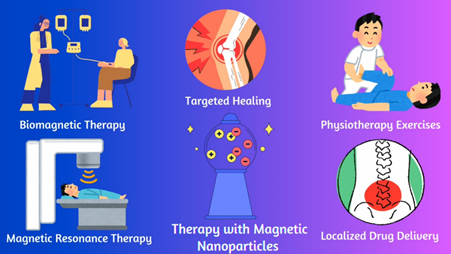Nano-magnetism unleashed: Targeted healing in yoga and physiotherapy with magnetic nanoparticles
Abstract
This review article explores the innovative applications of magnetic nanoparticles (MNPs) in yoga and physiotherapy for targeted healing. MNPs’ unique magnetic properties enable precise treatment and minimal invasiveness, offering significant potential in medical applications. Recent studies highlight the promising integration of MNPs into yoga and physiotherapy, enhancing the efficacy of these interventions by precisely targeting affected areas. This review also examines nanotechnology’s pivotal role in modern medical practices, showcasing MNPs’ contributions to pain management and tissue regeneration. By analyzing current developments and future prospects, the article aims to inspire further research and innovation in MNP-based targeted healing within yoga and physiotherapy.
References
[1]Friedrich RP, Cicha I, Alexiou C. Iron oxide nanoparticles in regenerative medicine and tissue engineering. Nanomaterials. 2021; 11(9): 2337. doi: 10.3390/nano11092337
[2]Joudeh N, Linke D. Nanoparticle classification, physicochemical properties, characterization, and applications: a comprehensive review for biologists. Journal of Nanobiotechnology. 2022; 20(1): 262. doi: 10.1186/s12951-022-01477-8
[3]Asoufi HM, Al-Antary TM, Awwad AM. Magnetite (Fe3O4) Nanoparticles Synthesis and Anti Green Peach Aphid Activity (Myzuspersicae Sulzer). Journal of Computational Biology. 2018; 6(1). doi: 10.15640/jcb.v6n1a2
[4]Avasthi A, Caro C, Pozo-Torres E, et al. Magnetic Nanoparticles as MRI Contrast Agents. Topics in current chemistry (Cham). 2020; 378(3): 40. doi: 10.1007/s41061-020-00302-w
[5]Liu S, Yu B, Wang S, et al. Preparation, surface functionalization and application of Fe3O4 magnetic nanoparticles. Advances in Colloid and Interface Science. 2020; 102165. doi: 10.1016/j.cis.2020.102165
[6]Mirza S, Ahmad MS, Shah MIA, Ateeq M. Magnetic nanoparticles: drug delivery and bioimaging applications. In: Metal Nanoparticles for Drug Delivery and Diagnostic Applications. Elsevier; 2020. pp. 189-213.
[7]Nalbandian L, Patrikiadou E, Zaspalis V, et al. Magnetic Nanoparticles in Medical Diagnostic Applications: Synthesis, Characterization and Proteins Conjugation. Current Nanoscience. 2015; 12(4): 455-468. doi: 10.2174/1573413712666151210230002
[8]Nacev A, Beni C, Bruno O, Shapiro B. Magnetic nanoparticle transport within flowing blood and into surrounding tissue. Nanomedicine (London, England). 2010; 5(9): 1459-1466. doi: 10.2217/nnm.10.104
[9]Garanina AS, Naumenko VA, Nikitin AA, et al. Temperature-controlled magnetic nanoparticles hyperthermia inhibits primary tumor growth and metastases dissemination. Nanomedicine: Nanotechnology, Biology and Medicine. 2020; 25: 102171. doi: 10.1016/j.nano.2020.102171
[10]Gupta AK, Naregalkar RR, Vaidya VD, Gupta M. Recent advances on surface engineering of magnetic iron oxide nanoparticles and their biomedical applications. Nanomedicine. 2007; 2(1): 23-39. doi: 10.2217/17435889.2.1.23
[11]Xia Y, Sun J, Zhao L, et al. Magnetic field and nano-scaffolds with stem cells to enhance bone regeneration. Biomaterials. 2018; 183: 151-170. doi: 10.1016/j.biomaterials.2018.08.040
[12]Sensenig R, Sapir Y, MacDonald C, et al. Magnetic nanoparticle-based approaches to locally target therapy and enhance tissue regeneration in vivo. Nanomedicine. 2012; 7(9): 1425-1442. doi: 10.2217/nnm.12.109
[13]Weaver JB, Ness DB, Fields J, et al. Identifying in vivo inflammation using magnetic nanoparticle spectra. Physics in Medicine & Biology. 2020; 65(12): 125003. doi: 10.1088/1361-6560/ab8afd
[14]Zanganeh S, Hutter G, Spitler R, et al. Iron oxide nanoparticles inhibit tumour growth by inducing pro-inflammatory macrophage polarization in tumour tissues. Nature nanotechnology. 2016; 11(11): 986-994. doi: 10.1038/nnano.2016.168
[15]Li X, Wang Y, Shi L, et al. Magnetic targeting enhances the cutaneous wound healing effects of human mesenchymal stem cell-derived iron oxide exosomes. Journal of Nanobiotechnology. 2020; 18(1): 113. doi: 10.1186/s12951-020-00670-x
[16]Lu Z, Yu D, Nie F, et al. Iron Nanoparticles Open Up New Directions for Promoting Healing in Chronic Wounds in the Context of Bacterial Infection. Pharmaceutics. 2023; 15(9): 2327. doi: 10.3390/pharmaceutics15092327
[17]Fuhrer R, Athanassiou EK, Luechinger NA, Stark WJ. Crosslinking metal nanoparticles into the polymer backbone of hydrogels enables preparation of soft, magnetic field-driven actuators with muscle-like flexibility. Small. 2009; 5(3): 383-388. doi: 10.1002/smll.200801091
[18]Gao F, Li X, Zhang T, et al. Iron nanoparticles augmented chemodynamic effect by alternative magnetic field for wound disinfection and healing. Journal of Controlled Release. 2020; 324: 598-609. doi: 10.1016/j.jconrel.2020.06.003
[19]Kusigerski V, Illes E, Blanusa J, et al. Magnetic properties and heating efficacy of magnesium doped magnetite nanoparticles obtained by co-precipitation method. Journal of Magnetism and Magnetic Materials. 2019; 475: 470-478. doi: 10.1016/j.jmmm.2018.11.127
[20]Alves D, Araújo JC, Fangueiro R, Ferreira DP. Localized Therapeutic Approaches Based on Micro/Nanofibers for Cancer Treatment. Molecules. 2023; 28(7): 3053. doi: 10.3390/molecules28073053
[21]Blanco-Mantecon M, O’Grady K. Interaction and size effects in magnetic nanoparticles. Journal of Magnetism and Magnetic Materials. 2006; 296(2): 124-133. doi: 10.1016/j.jmmm.2004.11.580
[22]Yang S, Jee S, Hwang SL, Sohn MK. Strengthening of quadriceps by neuromuscular magnetic stimulation in healthy subjects. PM&R. 2017; 9(8): 767-773. doi: 10.1016/j.pmrj.2016.12.002
[23]Sun R, Chen H, Zheng J, et al. Composite scaffolds of gelatin and Fe3O4 nanoparticles for magnetic hyperthermia-based breast cancer treatment and adipose tissue regeneration. Advanced Healthcare Materials. 2023; 12(9): 2202604. doi: 10.1002/adhm.202202604
[24]Del Sol-Fernández S, Martínez-Vicente P, Gomollón-Zueco P, et al. Magnetogenetics: Remote activation of cellular functions triggered by magnetic switches. Nanoscale. 2022; 14(6): 2091-2118. doi: 10.1039/d1nr06303k
[25]Wu PC, Hsiao HT, Lin YC, et al. The analgesia efficiency of ultrasmall magnetic iron oxide nanoparticles in mice chronic inflammatory pain model. Nanomedicine: Nanotechnology, Biology and Medicine. 2017; 13(6): 1975-1981. doi: 10.1016/j.nano.2017.05.005
[26]Wu PC, Shieh DB, Hsiao HT, et al. Magnetic field distribution modulation of intrathecal delivered ketorolac iron-oxide nanoparticle conjugates produce excellent analgesia for chronic inflammatory pain. Journal of Nanobiotechnology. 2018; 16(1). doi: 10.1186/s12951-018-0375-9
[27]Liu M, Yu W, Zhang F, et al. Fe3O4@Polydopamine-Labeled MSCs Targeting the Spinal Cord to Treat Neuropathic Pain Under the Guidance of a Magnetic Field. International Journal of Nanomedicine. 2021; 16: 3275-3292. doi: 10.2147/ijn.s296398
[28]Hajba L, Guttman A. The use of magnetic nanoparticles in cancer theranostics: Toward handheld diagnostic devices. Biotechnology Advances. 2016; 34(4): 354-361. doi: 10.1016/j.biotechadv.2016.02.001
[29]Yun SM, Kim M, Kwon YW, et al. Recent Advances in Wearable Devices for Non-Invasive Sensing. Applied Sciences. 2021; 11(3): 1235. doi: 10.3390/app11031235
[30]Li Y, Liu X, Zhang Y, et al. A flexible wearable device coupled with injectable Fe3O4 nanoparticles for capturing circulating tumor cells and triggering their deaths. Biosensors and Bioelectronics. 2023; 235: 115367. doi: 10.1016/j.bios.2023.115367
[31]Ahmed A, Hassan I, Mosa IM, et al. An Ultra-Shapeable, Smart Sensing Platform Based on a Multimodal Ferrofluid‐Infused Surface. Advanced Materials. 2019; 31(11). doi: 10.1002/adma.201807201
[32]Ramasubramanian B, Reddy VS, Chellappan V, et al. Emerging Materials, Wearables, and Diagnostic Advancements in Therapeutic Treatment of Brain Diseases. Biosensors. 2022; 12(12): 1176. doi: 10.3390/bios12121176
[33]Lin Y, Zhang K, Zhang R, et al. Magnetic nanoparticles applied in targeted therapy and magnetic resonance imaging: crucial preparation parameters, indispensable pre-treatments, updated research advancements and future perspectives. Journal of Materials Chemistry B. 2020; 8(28): 5973-5991. doi: 10.1039/d0tb00552e
[34]Alavijeh AA, Barati M, Barati M, Dehkordi HA. The potential of magnetic nanoparticles for diagnosis and treatment of cancer based on body magnetic field and organ-on-the-chip. Advanced pharmaceutical bulletin. 2019; 9(3): 360-373. doi: 10.15171/apb.2019.043
[35]Colbert AP, Wahbeh H, Harling N, et al. Static Magnetic Field Therapy: A Critical Review of Treatment Parameters. Evidence-Based Complementary and Alternative Medicine. 2009; 6: 392815. doi: 10.1093/ecam/nem131
[36]Basford JR. A historical perspective of the popular use of electric and magnetic therapy. Archives of Physical Medicine and Rehabilitation. 2001; 82(9): 1261-1269. doi: 10.1053/apmr.2001.25905
[37]Zhang X, Lang B, Yu W, et al. Magnetically induced anisotropic conductive hydrogels for multidimensional strain sensing and magnetothermal physiotherapy. Chemical Engineering Journal. 2023; 474: 145832. doi: 10.1016/j.cej.2023.145832
[38]Etheridge ML, Bischof JC. Optimizing Magnetic Nanoparticle Based Thermal Therapies Within the Physical Limits of Heating. Annals of Biomedical Engineering. 2012; 41(1): 78-88. doi: 10.1007/s10439-012-0633-1
[39]Kwak CJ, Kim YL, Lee SM. Effects of elastic-band resistance exercise on balance, mobility and gait function, flexibility and fall efficacy in elderly people. Journal of Physical Therapy Science. 2016; 28(11): 3189-3196. doi: 10.1589/jpts.28.3189
[40]Rathleff MS, Bandholm T, McGirr KA, et al. New exercise-integrated technology can monitor the dosage and quality of exercise performed against an elastic resistance band by adolescents with patellofemoral pain: an observational study. Journal of Physiotherapy. 2016; 62(3): 159-163. doi: 10.1016/j.jphys.2016.05.016
[41]Selva-Sarzo F, Fernández-Carnero S, Sillevis R, et al. The direct effect of magnetic tape® on pain and lower-extremity blood flow in subjects with low-back pain: a randomized clinical trial. Sensors. 2021; 21(19): 6517. doi: 10.3390/s21196517
[42]Hillion A, Hallali N, Clerc P, et al. Real-time observation and analysis of magnetomechanical actuation of magnetic nanoparticles in cells. Nano Letters. 2022; 22(5): 1986-1991. doi: 10.1021/acs.nanolett.1c04738
[43]Włodarczyk A, Gorgoń S, Radoń A, Bajdak-Rusinek K. Magnetite Nanoparticles in Magnetic Hyperthermia and Cancer Therapies: Challenges and Perspectives. Nanomaterials (Basel, Switzerland). 2022; 12(11). doi: 10.3390/nano12111807
[44]Szwed M, Marczak A. Application of Nanoparticles for Magnetic Hyperthermia for Cancer Treatment—The Current State of Knowledge. Cancers. 2024; 16(6): 1156. doi: 10.3390/cancers16061156
[45]kianfar E. Magnetic Nanoparticles in Targeted Drug Delivery: A Review. Journal of Superconductivity and Novel Magnetism. 2021; 34(7): 1709-1735. doi: 10.1007/s10948-021-05932-9
[46]Kostevšek N. A Review on the Optimal Design of Magnetic Nanoparticle-Based T2 MRI Contrast Agents. Magnetochemistry. 2020; 6(1): 11. doi: 10.3390/magnetochemistry6010011
[47]Bashar I, Ihab MO. Magnetic Nanoparticles as MRI Contrast Agents. In: Lachezar M (editor). Magnetic Resonance Imaging. Rijeka: IntechOpen; 2019. p. 4.
[48]Peng E, Wang F, Xue JM. Nanostructured magnetic nanocomposites as MRI contrast agents. Journal of Materials Chemistry B. 2015; 3(11): 2241-2276. doi: 10.1039/c4tb02023e
[49]Chen S, Saeed AFUH, Liu Q, et al. Macrophages in immunoregulation and therapeutics. Signal Transduction and Targeted Therapy. 2023; 8(1): 207. doi: 10.1038/s41392-023-01452-1
[50]Ding H, Zhang Y, Mao Y, et al. Modulation of macrophage polarization by iron-based nanoparticles. Medical Review. 2023; 3(2): 105-122. doi: 10.1515/mr-2023-0002
[51]Vilas-Boas V, Carvalho F, Espiña B. Magnetic Hyperthermia for Cancer Treatment: Main Parameters Affecting the Outcome of In Vitro and In Vivo Studies. Molecules. 2020; 25(12): 2874. doi: 10.3390/molecules25122874
[52]Chung S, Revia RA, Zhang M. Iron oxide nanoparticles for immune cell labeling and cancer immunotherapy. Nanoscale Horizons. 2021; 6(9): 696-717. doi: 10.1039/d1nh00179e
[53]Cheng HLM. A primer on in vivo cell tracking using MRI. Frontiers in Medicine. 2023;10.
[54]Dobrovolskaia MA, McNeil SE. Immunological properties of engineered nanomaterials. Nature Nanotechnology. 2007; 2(8): 469-478. doi: 10.1038/nnano.2007.223
[55]Singh N, Jenkins GJ, Asadi R, Doak SH. Potential toxicity of superparamagnetic iron oxide nanoparticles (SPION). Nano Reviews. 2010; 1: 5358. doi: 10.3402/nano.v1i0.5358
[56]Shubayev VI, Pisanic TR, Jin S. Magnetic nanoparticles for theragnostics. Advanced Drug Delivery Reviews. 2009; 61(6): 467-477. doi: 10.1016/j.addr.2009.03.007
[57]Mahmoudi M, Sant S, Wang B, et al. Superparamagnetic iron oxide nanoparticles (SPIONs): development, surface modification and applications in chemotherapy. Advanced Drug Delivery Reviews. 2011; 63(1-2): 24-46. doi: 10.1016/j.addr.2010.05.006

Copyright (c) 2024 Noor Zulfiqar, Maryam Asif, Hafiz Salman Tayyab, Misbah Shaukat, Humna Mehmood, Fawad Inam

This work is licensed under a Creative Commons Attribution 4.0 International License.
Authors contributing to this journal agree to publish their articles under the Creative Commons Attribution 4.0 International License, allowing third parties to share their work (copy, distribute, transmit) and to adapt it for any purpose, even commercially, under the condition that the authors are given credit. With this license, authors hold the copyright.











